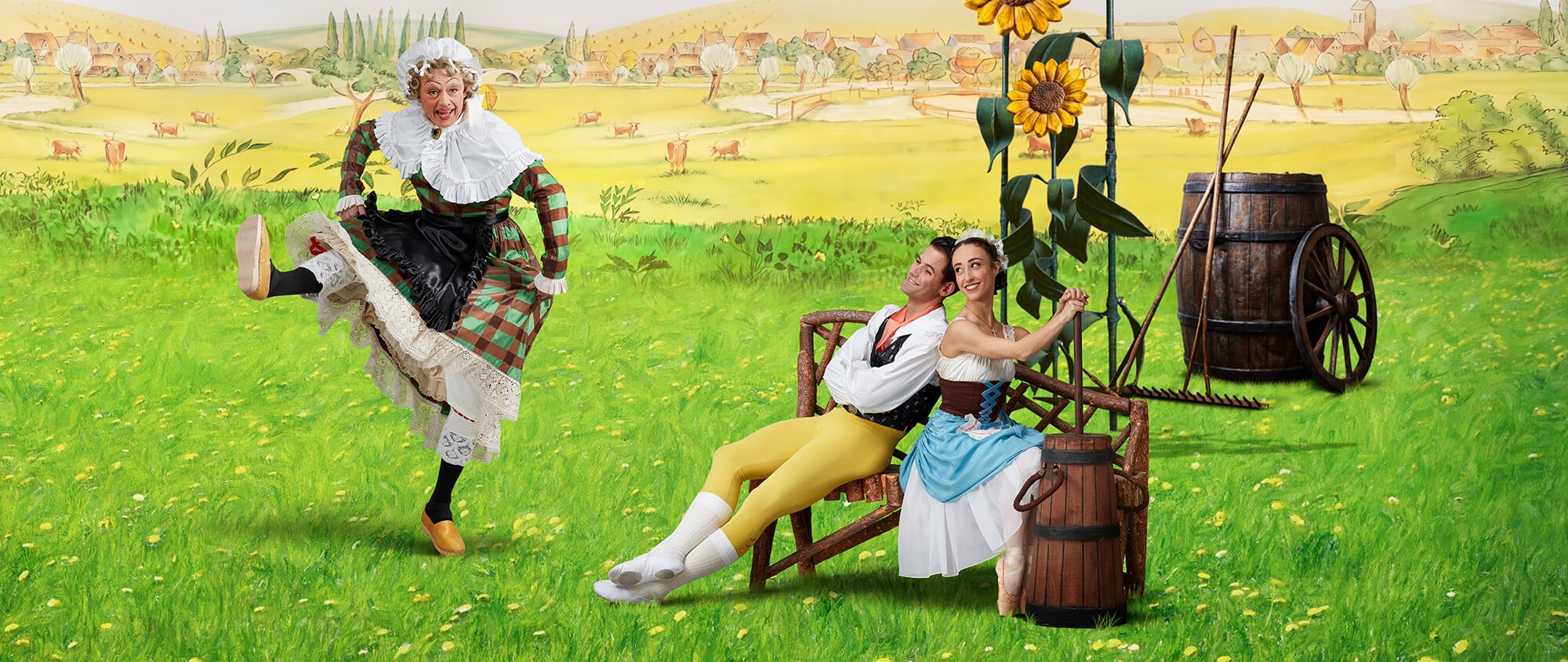Alastair Macaulay: Why Ashton’s Fille never grows stale
balletLa Fille mal gardée – Birmingham Royal Ballet at Sadler’s Wells
Review by Alastair Macaulay
Frederick Ashton’s full-length ballet “La Fille mal gardée” (1960) is a comic study of rural innocence that runs far deeper than many earnestly serious works. With designs by the wittily satirical ultra-English cartoonist Osbert Lancaster, it seems itself at first to be just an endearing cartoon romp. The opening scene has a dancing cockerel and dancing hens who at once take us into a Beatrix Potter realm of heightened realism. The farm is run by the widow Simone, a pantomime-dame drag role without camp. Her daughter Lise churns the milk and argues with Simone about how much the farm workers should be paid.
Yet the fabric of this ballet goes far beyond caricature. Ashton keeps placing his faith in dance itself. (Lise does échappés and pas de bourrée on point while she churns the milk.) At first, all the ballet’s rhythms are chirpy, perky, and abrupt, but soon they acquire longer and more flowing phrases, while the dancers’ lines likewise become longer and more spacious. Classicism, tenderness, community, virtuosity, love, and poetry begin to beam through these characters, like vital forces, transfiguring the simple story into something transcendent.
In Act One Scene Two, characters bring on a maypole, whose ribbons Ashton weaves into enchantingly intricate patterns – the most complicated traceries within a ballet that has already employed ribbons unforgettably. But in the wedding celebrations of Act Two Ashton creates, without ribbons, an all- human maypole, with eighteen dancers organised as six rotating spokes (except that the spokes keep changing their own geometries), while six others weave inward and outward like threads. These are just rural folk, but the energies, patterns, rhythms, and harmonies given them by Ashton are of supreme and exuberant brilliance.
Birmingham Royal Ballet has revived Ashton’s “La Fille” this autumn, bringing three casts of the leading couple of Sadler’s Wells on Friday 25 and Saturday 26. It’s almost fifty years since I first watched this classic – years during which I’ve watched it danced many dozens of times, between New York and Turin – but I watched these three performances with wonder, still learning more about Ashton’s poetic gift at each performance.
A few alterations have crept in since Ashton’s death. One example: Lise and Colas enter for their grand pas de deux and place hands on each other’s shoulders, they used to greet each other by kissing each other’s cheeks (left, right, left), but now they merely peer over each other’s shoulders (left, right, left) as if to check the coast is clear – one of the several subtly wrong-headed changes made by the foolishly well-intentioned Alexander Grant (1925-2011j, to whom Ashton bequeathed the ballet (and who at one point was changing it for the worse at every performance).
Yet watching the three casts of lovers – Beatrice Parma and Enrique Bejarano Vidal (Friday), Yu Kurihara and Yasiel Hodelín Bello (Saturday matinee), and Sofia Liñares and Lachlan Monaghan – I found each cast truer and more touching than the last. When this revival returns to repertory, I hope the Lises will learn that several of her dances (the wedding pas de deux above all) are more touching when played without smiles. Nadia Nerina, Ashton’s original Lise, always insisted that, in the mimed daydream of having children, “pregnancy” was to be indicated gently (“Listen to the music”), not massively (as all Lises now play it).
The hardest role to bring off today (and the greatest creation of Grant’s own long stage career) is Lise’s adorably feckless suitor Alain, a sunny and ultimately irrepressible simpleton who is more devoted to his red umbrella than to Lise. Here, again, Ashton’s view of character transcends caricature. A sequence at these performances that shone out with stunning pathos was Alain’s forlorn pas de deux with his father Thomas, stage left, while Simone, stage right, gave her blessing to the union of Lise and Colas. With Thomas as his supportive partner, Alain slowly arched forward in one slow and amazing arc, then arched backward in another, his outstretched hand still holding the wedding ring no bride has yet claimed. This isn’t Alain’s final moment – he ends the ballet by joyously reclaiming his beloved brolly – but it’s the one that gives him greatest depth.
“La Fille mal gardée,” first choreographed in 1789 in Bordeaux, has been choreographed in several versions to several scores. Ashton’s 1960 masterpiece is to a score generally attributed to Ferdinand Hérold but cobbled together for Ashton by John Lanchbery in an arrangement that includes whole items by Rossini, Donizetti, Hertel, and others. This is how many scores of the early nineteenth century were assembled (and many scores for silent films in the early twentieth century). Ashton makes the most of every element. In this century alone, it has been danced by the Bolshoi Ballet in Moscow, by American Ballet Theatre in New York, and by the Paris Opera Ballet. We should apply to it the words that Evelyn Waugh spoke in 1961 about P.G.Wodehouse: “Mr Wodehouse’s idyllic world can never stale. He will continue to release future generations from captivity that may be more irksome than out o0wn. Her has made a world for us to live in and delight in.”
Brb.org.uk/WhatsOn







Comments